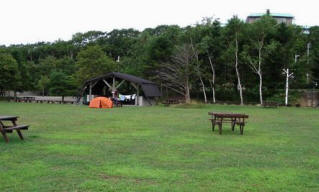


Many designated campgrounds are in parks, hidden in the trees or with large well kept open grassy areas.
This one was closed in September after the season but no problem camping, we were told. It was situated below a hill with a wonderful onsen on top.

There were signs in the kitchen pavilion which we could not read so suspected it might be
unpotable water.
 An
email to our Japanese friends confirmed it was OK to drink the water.
An
email to our Japanese friends confirmed it was OK to drink the water.There is no problem with water in Japan. The sign turned out to be something about not leaving your watermelons in the river. There is a big problem with crows stealing food in many campgrounds.
There is usually a pavilion with long water troughs in a kitchen area and another with long troughs for charcoal grills.

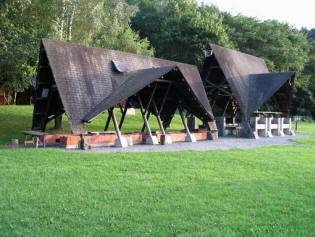


Many are located in huge sporting grounds and have wonderful clean facilities, of various types, which are left open even after the season.
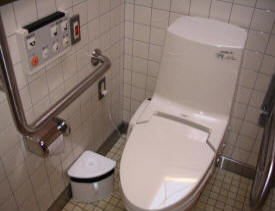 We
often washed out our bike shorts with hot water in the sinks of the
handicap toilet facilities. Many of the toilets had HEATED SEATS!!
We
often washed out our bike shorts with hot water in the sinks of the
handicap toilet facilities. Many of the toilets had HEATED SEATS!!
 They also had various washing options.
They also had various washing options.
This made CAMPING A REAL LUXUARY!
Even the older style toilets were always clean and offered simple options.





Because of heavy dew, and often rain in the night, we preferred to pitch our tent under a ramada or shelter. We even pitched it in the kitchens. We were told this was acceptable for us and we were never asked to leave.


Other types of accommodation were often found in the campgrounds. These
teepee type cabins were very basic and rent for about $20 a night.
Or you can pitch your tent within designated areas nearby.

Most often we were the only campers. Alone one day, then on a
weekend we were surrounded.

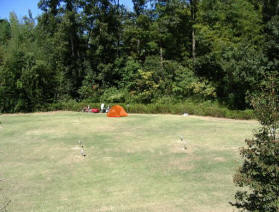
The Japanese are very quiet campers.
Often times they would come in, set up late and we would wake to find a field of little mushroom tents had sprouted up during the night.

A few of the more expensive campgrounds were very organized. NO
campgrounds allow vehicles to park next to the tents.

Carts with wheels are supplied to carry in your gear. The exception was for bicycles. They were always allowed to be kept next to our tent

The exception to not parking next to your site is the very expensive Auto Camps.
Cost for these start around $50
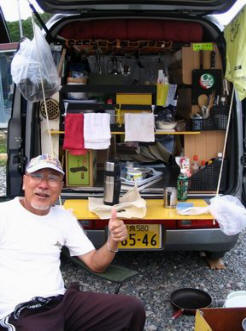
'FREE CAMPING' is also an accepted practice in Japan.

It is nice to carry a card written in Japanese explaining that you are looking for a camp spot for one night only and will not build fires or leave any trash. In this case it is best to set up after dark and leave early. Trash cans are rarely supplied so you must carry yours out. (Ours ended up mostly in the Seicomart bins.)
 Some
camping parks had great facilities like this favorite one near
Kami-Furano Hokkaido. It had a laundry, refrigerator, microwave, store and
seating area with a TV in the main building. And of course real
Japanese baths. A bit more expensive but still only $10 a night
for a tent spot.
Some
camping parks had great facilities like this favorite one near
Kami-Furano Hokkaido. It had a laundry, refrigerator, microwave, store and
seating area with a TV in the main building. And of course real
Japanese baths. A bit more expensive but still only $10 a night
for a tent spot.


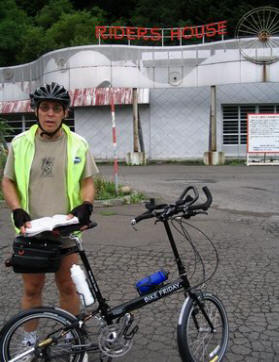


We find no matter where we are camped, under a pavilion, behind a sea wall, in someone's back yard or back porch, or on a soft mossy terrace...inside the 'golden pagoda' it is still our own familiar space, And OH YES.....we always choose a campground as close as we can get to the ONSEN or SENTO. (also a symbol in Mappel Guide Books.) Without this wonderful ending to a hard hot days ride, you can bet even the 'golden pagoda' would not be an option.

Sento around the corner, Interneto, washy clothes, fully tummy, goldy pagody,
O YA SAMI NASI (Good Night)
